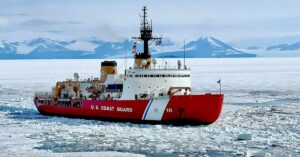
Edison Chouest’s Vessel Sets Sail On High-Tech Imaging Expedition To Titanic Wreck Site
July 11, 2024
Ukraine Seizes Cargo Ship & Detains Its Captain For Transporting Looted Grain To Russia
July 12, 2024

The United States, Canada and Finland have formed a consortium to build icebreaker ships to counter China and Russia’s strategic advancements in the polar regions.
The Icebreaker Collaboration Effort (ICE) pact, announced on July 11, 2024, at the three-day NATO summit in Washington, aims to expand the partners’ shipbuilding capabilities and increase their presence in the Arctic and Antarctic regions.
A senior US administration official described the ICE agreement as a “strategic imperative”, highlighting the need to project power and enforce international norms in the polar regions.
The agreement aims to combine allies’ demand to increase shipbuilding ability, addressing the current icebreaking capability gap.
The United States presently operates only two ageing icebreakers, while China and Russia are expanding their fleets.
Over the next decade, the United States allies want to construct 70 to 90 icebreakers.
According to the official, the partnership will strengthen the shipbuilding industries in each nation, generating well-paid employment in shipyards, marine equipment manufacturers, and related services across all three countries.
The ICE agreement also calls for the partner nations to share their capabilities, experience, and information among the partner nations.
The decision comes as Arctic ice packs shrink due to climate change, enabling new shipping routes connecting the Pacific and Atlantic oceans.
Western countries are becoming increasingly concerned about China’s polar activities, which could strengthen its operational and surveillance capabilities.
Russia, with its fleet of over 40 icebreakers, and China, with an expanding fleet, have been working together to establish Arctic shipping routes. This collaboration gained recognition following Russia’s 2022 invasion of Ukraine.
Canada and Finland contribute invaluable expertise to the ICE agreement. Canada’s National Shipbuilding Strategy has existed for over a decade, but development could have been faster.
Seaspan Shipyards in Vancouver recently stated that their new icebreaker design is just 70% complete.
Additionally, Quebec’s Davie Shipbuilding has been contracted to design and build seven massive icebreakers and two hybrid-powered ferries, costing $8.5 billion.
The ICE agreement is a crucial response to the decreasing icebreaking fleets of the United States and Canada.
The United States Coast Guard recently announced the urgent need for eight to ten new icebreakers to replace its ageing fleet.
The ICE pact not only intends to increase shipbuilding capacity but also signals to China and Russia that the allies plan to maintain a presence in the Arctic regions.
Finnish and Canadian expertise in icebreaker design and construction is considered superior to that of the United States.
The ICE deal takes advantage of this expertise, mainly through Davie Shipbuilding, which recently acquired Finland’s Helsinki Shipyard Oy.
The acquisition is anticipated to improve much-needed icebreakers’ production efficiency, speed, and cost-effectiveness.
Reference: Reuters, CBC
US, Canada & Finland To Build Icebreaker Ships To Counter China & Russia In Polar Regions appeared first on Marine Insight – The Maritime Industry Guide
Source: Maritime Shipping News


